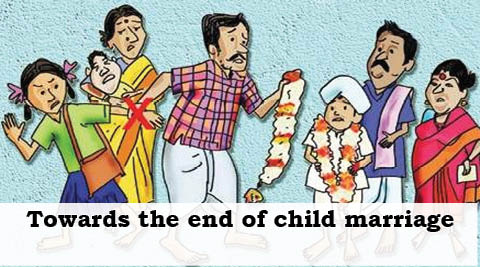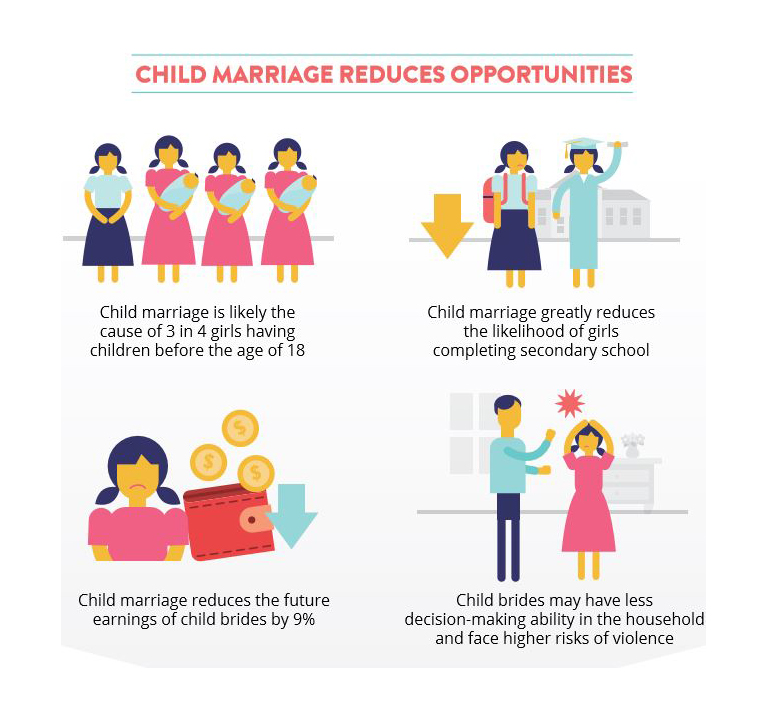Context:
Child marriage remains a serious challenge in India, despite the existence of strict laws and widespread awareness campaigns. With deeply rooted cultural practices, poverty, and gender inequality continuing to drive early marriages, interventions that combine legal enforcement with social reform are essential. In a path-breaking move, the tribal-dominated Banswara district in southern Rajasthan has adopted a strong legal mechanism to prevent child marriage—making court-issued injunction orders compulsory for any reported or impending instance.
Banswara’s New SOP: A Legal Tool to Stop Child Marriages:
Over 70% of Banswara’s population belongs to tribal communities, and the district has long struggled with a high child marriage rate—25%, as per NFHS-5 (2019–21), compared to the national average of 23.3%. To address this, the Banswara administration has made it mandatory to obtain an injunction order from the Judicial Magistrate under Section 13(1) of the Prohibition of Child Marriage Act, 2006 for any reported or suspected child marriage. This legally binding order prevents the marriage from taking place and makes any violation a criminal offence.
Key Highlights of the SOP:
- Court-issued injunction: Any report of an impending child marriage will now be addressed by applying for a formal injunction order through the Sub-Divisional Magistrate.
- Legal enforcement: Violation of an injunction order is a punishable offence. It creates a documented legal record, unlike previous verbal assurances or written undertakings.
- Rapid response: Joint teams comprising officials from the Police, Women and Child Development Department, and NGOs will act immediately on reports.
- Detailed documentation: A full report—including names, ages, and family details—is to be submitted before the Magistrate.
- Training and compliance: District-level training programmes are being conducted for effective implementation of the SOP.
This initiative, the first of its kind in Rajasthan, signals a shift from informal preventive measures to a legally enforceable strategy.
Understanding Child Marriage in India:
Child marriage refers to any marriage where at least one party is under the legal minimum age—18 for girls and 21 for boys under Indian law. This practice undermines children’s rights, perpetuates poverty, and fuels gender discrimination.
According to UNICEF (2021):
- India is home to 223 million child brides, the largest number globally.
- Despite declining rates in urban areas, rural and tribal regions see persistently high prevalence.
Causes of Child Marriage in India:
Child marriage is driven by interrelated factors:
1. Deep-rooted Traditions and Family Honour
o Many communities believe marrying girls early preserves family honour and avoids premarital relationships.
o Social customs often prioritise marriage over education or economic independence.
2. Poverty and Economic Insecurity
o Poor families see marriage as a way to reduce expenses and responsibility.
o Early marriages are linked to lower dowry demands.
3. Gender Inequality
o Girls are viewed as burdens rather than individuals with rights and potential.
o Patriarchal norms restrict girls’ autonomy and decision-making.
4. Lack of Education
o Illiterate families may be unaware of the legal and health consequences of child marriage.
o Girls who are out of school have fewer alternatives and less power to resist.
5. Safety Concerns
o Families sometimes marry off daughters early to protect them from harassment or assault.
6. Weak Law Enforcement
o Even though laws exist, low conviction rates, poor reporting, and limited administrative action allow the practice to persist.
Consequences of Child Marriage:
Child marriage has lasting adverse impacts:
- Maternal and Infant Health Risks:
- Young brides face higher rates of pregnancy complications and maternal mortality.
- Their children are more likely to be undernourished or die young.
- Educational Disruption:
- Girls married early typically drop out of school, limiting their employment prospects.
- Poverty Trap:
- Lack of education and early motherhood perpetuate intergenerational poverty.
- Psychological Distress:
- Many child brides experience depression and anxiety.
- Domestic Violence:
- Younger brides are more vulnerable to abuse and exploitation.
- Population Growth:
- Early and repeated pregnancies contribute to higher fertility rates.
Legal Framework in India:
India has a robust legal architecture to address child marriage:
- Prohibition of Child Marriage Act, 2006 (PCMA):
- Sets legal marriage ages.
- Penalises those who solemnise, facilitate, or fail to prevent child marriages.
- Authorises states to appoint Child Marriage Prohibition Officers (CMPOs).
- POCSO Act, 2012:
- Considers sexual relations with minors as statutory rape.
- Right to Education Act, 2009:
- Provides free, compulsory education to reduce school dropouts.
- Dowry Prohibition Act, 1961:
- Aims to reduce dowry pressures that encourage early marriage.
Government Efforts and Programs
- Beti Bachao Beti Padhao:
- Promotes survival, protection, and education of girls.
- Kanyashree Prakalpa (West Bengal):
- Provides financial incentives for girls to stay in school and delay marriage.
- Apni Beti Apna Dhan (Haryana):
- Encourages delayed marriage through conditional cash transfers.
- Childline 1098:
- Emergency helpline for children in crisis.
- Partnerships:
- UNICEF and NGOs train local leaders and youth volunteers to identify and prevent child marriages.
Supreme Court Guidelines for Prevention:
Recognising persistent gaps, the Supreme Court has issued detailed directives to strengthen prevention, including:
- Appointment of Full-time CMPOs: Officers dedicated solely to preventing child marriages.
- Empowering Magistrates: Magistrates can take suo motu action against suspected child marriages.
- Fast-Track Courts: Special courts for swift resolution of child marriage cases.
- Community Certification: Villages can be declared “Child Marriage-Free”, similar to Swachh Bharat’s ODF certification.
- Mandatory Accountability: Public servants failing to act face penalties.
The Supreme Court has emphasised the need to leverage technology:
- A centralised reporting portal to register cases.
- Data analytics to identify high-risk areas and trends.
- Digital campaigns to inform communities in local languages.
Funding and Capacity Building
- Dedicated annual budget allocations for prevention.
- Training for police, teachers, health workers, and judicial officers.
- Utilisation of the Juvenile Justice Fund for rescue and rehabilitation.
Conclusion:
Banswara’s initiative marks a significant shift from informal approaches to a legal, documented process that empowers authorities to prevent child marriages effectively. While laws and schemes exist, real change happens when enforcement is combined with community engagement and sustained political will. Scaling similar interventions in other high-prevalence districts can help India advance toward its goal of ending child marriage and fulfilling the rights of every child.
This model highlights how legal innovation, administrative commitment, and civil society partnership can together drive social transformation.
| Main question: The practice of child marriage is not only a violation of human rights but also an impediment to achieving Sustainable Development Goals (SDGs). In this context, critically analyze the role of community engagement and technology in preventing child marriages. (250 words) |








